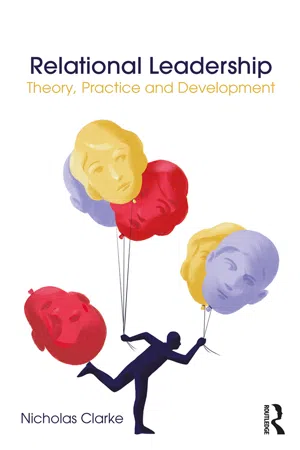Business
Responsible Leaders
Responsible leaders in business are individuals who prioritize ethical decision-making, sustainability, and social responsibility in their leadership approach. They are committed to creating a positive impact on their employees, communities, and the environment, while also ensuring the long-term success and integrity of their organizations.
Written by Perlego with AI-assistance
Related key terms
Related key terms
1 of 4
Related key terms
1 of 3
6 Key excerpts on "Responsible Leaders"
- eBook - ePub
Relational Leadership
Theory, Practice and Development
- Nicholas Clarke(Author)
- 2018(Publication Date)
- Routledge(Publisher)
7 Responsible LeadersHIPThere have been calls for a new form of leadership in conducting business due to globalisation, and the need to transcend the neo-economic instrumentalism that many argue gave rise to the collapse of financial markets in 2008 (Maak & Pless, 2006; Scherer & Palazzo, 2008). A poll conducted in France, Germany, Great Britain, Italy, Spain and the United States in 2009 found that 76 per cent of Americans and between 65–81 per cent of European adults, considered the behaviour of their business leaders was unethical or irresponsible (Harris Interactive, 2009). This new form of leadership requires new responsibilities that reflect a step change in the social contract between business and society. Where social responsibility and ethical behaviours are increasingly central to the exercise of leadership (Carroll & Shabana, 2010). Against this backdrop, the concept of responsible leadership has emerged that brings together notions of leadership, ethics and corporate social responsibility to underpin a new model of leadership better suited to the changing nature of global business (Doh & Stumpf, 2005; Waldman & Siegel, 2008).Although the field is only just emerging, most writers agree that Responsible Leadership requires a focus on leadership ethics, and a more comprehensive engagement with the full range of stakeholders affected by business to develop more socially Responsible Leadership behaviours (Waldman, 2011). This new form of leadership attempts to bridge leadership practice at the individual level, with the organisational level of corporate responsibility (Voegtlin, Patzer, & Scherer, 2012). As yet, though, a set of outcomes expected from Responsible Leadership has not been clearly articulated beyond the idea that Responsible Leaders should attempt to influence economic, environmental as well as outcomes of social value, that together comprise the triple bottom line (Savitz & Weber, 2006). Sometimes articulated that Responsible Leaders should ‘do no harm’ or ‘do good’ (Waldman & Galvin, 2008). - eBook - ePub
- Rune Todnem By, Bernard Burnes, Mark Hughes(Authors)
- 2023(Publication Date)
- Routledge(Publisher)
Conscious of the divide, it strives to remain reflexive about its post-positivist, normative roots while exploring the empirical reality of leading responsibly. Responsible Leadership places itself at the interface of leadership studies, ethics, and business ethics. It has embraced the reflective paucity on the new challenges of present leaders and (their) corporations to act ‘responsibly’ in a globalized world under the threat of severe or even existential ramifications in the case of defective behavior (e.g. Maak, 2007 ; Maak & Pless, 2006 ; Voegtlin et al., 2012). Among the different contributions, that of Maak and Pless are most notable, as their work are the most sensitive concerning the three illustrated problems of justification. Their work embeds Responsible Leadership in the stakeholder literature. Hence, leadership has to acknowledge an increasing cultural and moral diversity as well as the new role of the corporation in society. Maak and Pless (2006, p. 99) define Responsible Leadership as ‘a social-relational and ethical phenomenon, which occurs in social processes of interaction. (…) [It] takes place in interaction with a multitude of followers as stakeholders inside and outside the corporations’. It becomes ‘a values-based and through ethical principles driven relationship management between leaders and stakeholders who are connected through a shared sense of meaning and purpose through which they raise another to higher levels of motivation and commitment for achieving sustainable values creation and social change’ (Pless, 2007, p. 438). More recent is the politically extended concept of Responsible Leadership (see esp. Patzer, 2009, as well as Patzer & Scherer, 2010 ; Patzer et al., 2018 ; Voegtlin et al., 2012). Inspired by the discussions on political CSR (Scherer & Palazzo, 2007), it reflects upon the leader's responsibility in the context of the theory of deliberative democracy and discourse ethics (especially Habermas, 1993, 1996) - Sebastian B. Reiche, Günter K. Stahl, Mark E. Mendenhall, Gary R. Oddou(Authors)
- 2023(Publication Date)
- Routledge(Publisher)
Today, executives face socially conscious investors, customers, employees, and a public that expect businesses to take a larger and more responsible role in society. Accordingly, they need to understand and calibrate social and environmental issues that affect their firms and devise strategies that respond to challenges as varied as climate change, a COVID-19 pandemic, the rich–poor gap, and increased workforce diversity. They must also be prepared to deal with activist groups, the threat of protest, calls for greater transparency, and the dramatic increase in exposure provided by the internet and social media.Amid all these changes, business leaders still have to do what they have always had to do: produce growth, deliver results, develop relationships with people, and innovate to meet marketplace needs and beat competitors. What does it take for leaders to be successful in the business world today? It requires new forms of individual and collective learning.Leading Responsibly
In nearly every survey and study, leadership stands out as the number one factor driving responsible behavior in companies (Conference Board, 2016 ; PWC, 2016 ). This starts with the CEO, of course, but includes managers at every level and leaders of work councils. In popular imagination, the high-powered, profit-driven, take-charge model of leadership is the prototype for big business, particularly in the US, but in favor by degrees around the world (Khurana, 2002 ). Yet the benefits of that model are increasingly suspect.In a study of over 500 CEOs operating across 17 countries, for instance, researchers compared CEOs who gave primacy to economic factors (profits, cost control, and market share) in their decision-making versus those who stressed stakeholder values (customers, employee relations, environmental concerns, and communities). They found that economic leaders were seen as authoritarian by their direct reports, whereas CEOs with a stakeholder orientation were viewed as more visionary. Stakeholder CEOs were also more likely to lead firms that performed better financially, and their followers were more apt to show extra effort and make sacrifices for the sake of the firm (Waldman, Seigel, & Javidan, 2006- eBook - ePub
- Doris Schedlitzki, Magnus Larsson, Brigid Carroll, Michelle C. Bligh, Olga Epitropaki, Doris Schedlitzki, Magnus Larsson, Brigid Carroll, Michelle C. Bligh, Olga Epitropaki(Authors)
- 2023(Publication Date)
- SAGE Publications Ltd(Publisher)
Responsibility within leadership has been the subject of considerable research (e.g., Berns et al., 2009; Stahl & de Luque, 2014; Tsui, 2021; Waldman & Siegel, 2008). Despite its importance, scholars have bemoaned the lack of a comprehensive understanding of responsibility within leadership, which has impacted the progress of this important area of research (Tsui, 2021). We want to address two fundamental issues within the RL literature.First, while the existing literature addresses responsibility within leadership using the term ‘Responsible Leadership’ (RL), there is no unifying understanding of what RL means and encompasses (Maak et al., 2016; Miska & Mendhall, 2018). Various scholars have provided differing definitions, as well as explanations, for RL. We can contrast the earliest definition provided by Maak and Pless (2006) who define RL as a relational and ethical phenomenon, which occurs in social processes of interaction with those who affect or are affected by leadership and have a stake in the purpose and vision of the leadership relationship (2006, p. 99) with one of the most recent definitions provided by Lin et al. (2020) who define RL as a leader's ethical act of inspiring others through his/her motivating, communicating with, empowering and convincing employees to engage with responsible development and positive changes (2020, p. 1). Our review of these different approaches to RL has led us to identify four broad orientations that are common to the way in which RL is conceptualised. Responsible Leaders tend to: 1) adopt a multi-stakeholder orientation; 2) are moral and ethical and have altruistic motives; 3) seek to balance profit and societal outcomes; and 4) are able to influence and motivate subordinates to be involved in achieving common good for the organisation's wider stakeholders.Guided by stakeholder theory, several leadership scholars have advocated for RL to be considered as a separate theoretical construct which is substantially different from and superior to other leadership styles (e.g., Maak & Pless, 2006; Pless & Maak, 2011). They differentiate RL from other styles of leadership based on the fact that: current leadership theories tend to focus on specific personality characteristics (e.g., charisma and authenticity – see Chapter 9, Leadership as contextualised personality traits, Chapter 12, Authentic leadership or authenticity in leadership? and Chapter 13, Redefining followership) through which leaders exercise power over their followers; current leadership theories are also value-free where morality is absent; current leadership theories are solely internally focused; and current leadership theories are void of purpose (Maak & Pless, 2006; Pless & Maak, 2011). - eBook - ePub
- Nicola Pless, Thomas Maak(Authors)
- 2021(Publication Date)
- Routledge(Publisher)
Later, Maak et al. (2016 : 464) considered Responsible Leadership to be “a relational influence process between leaders and stakeholders geared towards the establishment of accountability in matters pertaining to organizational value creation.” Although “a unifying definition of Responsible Leadership has yet to emerge” (Maak et al., 2016 : 464; see also Miska & Mendenhall, 2018 ; Stahl & Sully De Luque, 2014), it is clear that Responsible Leadership takes place in interaction with multiple stakeholders both inside and outside the organization. Therefore, Responsible Leadership is based on the inclusion, collaboration, and cooperation with a plurality of stakeholders, with the dual purpose of long-term corporate development and the common good, via ethically sound behaviors. The literature does not distinguish Responsible Leadership style (i.e., behaviors) from Responsible Leadership mindset, the terms being sometimes used interchangeably (e.g., Maak, 2007 ; Pless & Maak, 2011). We adopt a different approach here: although Responsible Leadership is both a mindset and a style, they differ. While the former represents an orientation or disposition, the second involves action, or practice (Richardson, 2015). Miron-Spektor et al. (2018 : 27) defined a mindset as “a framework or lens that helps to interpret experiences” and to “organize complex reality.” Hamilton, Vohs, Sellier, and Meyvis (2011 : 13) defined mindsets as “sets of mental processes that produce a disposition or readiness to respond in a particular manner.” In our view, these definitions do not fully capture the normative component contained in the Responsible Leadership mindset. Therefore, our perspective is more consistent with Rhinesmith (1992 : 63, emphasis added) who defined a mindset as: a predisposition to see the world in a particular way that sets boundaries and provides explanations for why things are the way they are, while establishing guidance for ways in which we should behave - eBook - ePub
Corporate Behavior and Sustainability
Doing Well by Being Good
- Güler Aras, Coral Ingley(Authors)
- 2016(Publication Date)
- Gower(Publisher)
Serving a greater purpose, making a meaningful contribution to a good, just society, using resources thoughtfully, reflecting potential consequences of own actions on others (in a broad sense) Team members, stakeholders (including shareholders), society, the larger social and ecological environment Inviting stakeholders to share concerns, invite team members to contribute to co-creative processes, facilitate spaces for the enactment of purposeAs our models show, leadership tends to become more responsible in itself as the complexity of self development increases, in the sense that it gradually responds to larger groups of interested or concerned individuals, while only the most complex levels conceive of responsibility as a commitment generally going beyond attaining particular(istic) organizational goals and interests. Only they will therefore be capable and prepared to involve broader numbers of extra-organizational stakeholders without perceiving this as a threat to their personal or organizational identity. In other words, there are varying degrees of both responsibility and RL, depending on the extent to which the respective leader is able to transcend and contextualize his/her (organization’s/business’) primary needs and interests and see the latter as part of a larger context, i.e. of the social or even eco-system the respective organization is part of. Karen Litfin therefore suggests to talk about “responsability” due to the “wider expanse of reality (…) and capacity to respond” (Litfin 2003, p. 51).In the second part of this chapter, we will explore this claim in more detail. We will show that as complexity requirements increase, successful RL becomes less and less a matter of “enlightened individuals” possessing the “right“ personal traits and qualities but rather a matter of ongoing collaborative inquiry and effort. In fact, this claim is in line with late Lawrence Kohlberg’s assumption that his 6th order
Index pages curate the most relevant extracts from our library of academic textbooks. They’ve been created using an in-house natural language model (NLM), each adding context and meaning to key research topics.
Explore more topic indexes
Explore more topic indexes
1 of 6
Explore more topic indexes
1 of 4





